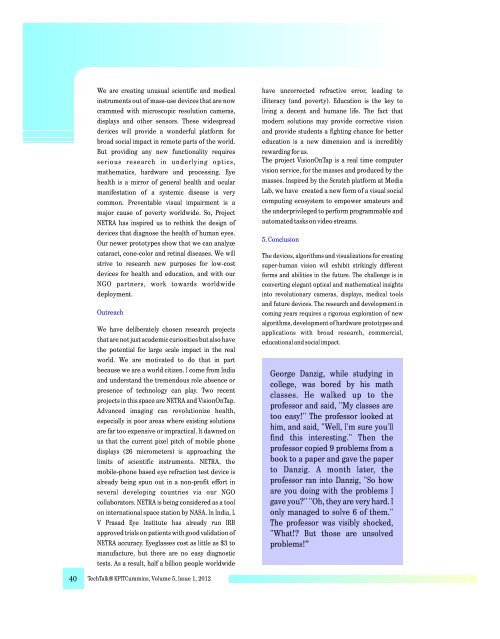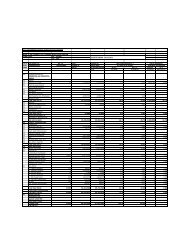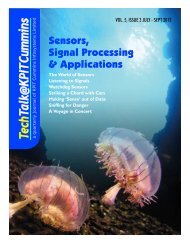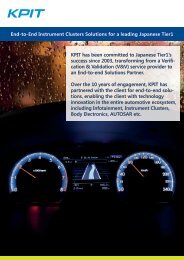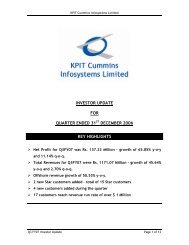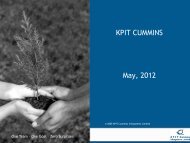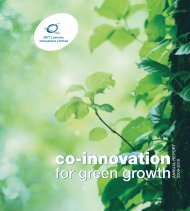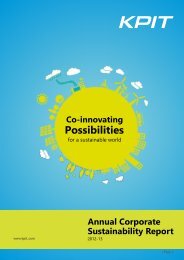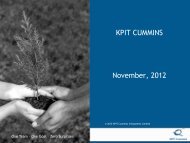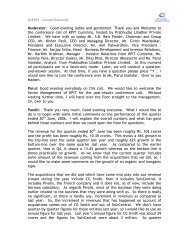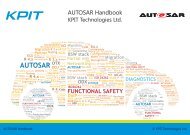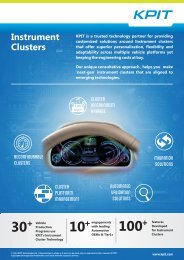INNOVATIONS FROM THE EDGE - KPIT
INNOVATIONS FROM THE EDGE - KPIT
INNOVATIONS FROM THE EDGE - KPIT
You also want an ePaper? Increase the reach of your titles
YUMPU automatically turns print PDFs into web optimized ePapers that Google loves.
We are creating unusual scientific and medical<br />
instruments out of mass-use devices that are now<br />
crammed with microscopic resolution cameras,<br />
displays and other sensors. These widespread<br />
devices will provide a wonderful platform for<br />
broad social impact in remote parts of the world.<br />
But providing any new functionality requires<br />
serious research in underlying optics,<br />
mathematics, hardware and processing. Eye<br />
health is a mirror of general health and ocular<br />
manifestation of a systemic disease is very<br />
common. Preventable visual impairment is a<br />
major cause of poverty worldwide. So, Project<br />
NETRA has inspired us to rethink the design of<br />
devices that diagnose the health of human eyes.<br />
Our newer prototypes show that we can analyze<br />
cataract, cone-color and retinal diseases. We will<br />
strive to research new purposes for low-cost<br />
devices for health and education, and with our<br />
NGO partners, work towards worldwide<br />
deployment.<br />
Outreach<br />
We have deliberately chosen research projects<br />
that are not just academic curiosities but also have<br />
the potential for large scale impact in the real<br />
world. We are motivated to do that in part<br />
because we are a world citizen. I come from India<br />
and understand the tremendous role absence or<br />
presence of technology can play. Two recent<br />
projects in this space are NETRA and VisionOnTap.<br />
Advanced imaging can revolutionize health,<br />
especially in poor areas where existing solutions<br />
are far too expensive or impractical. It dawned on<br />
us that the current pixel pitch of mobile phone<br />
displays (26 micrometers) is approaching the<br />
limits of scientific instruments. NETRA, the<br />
mobile-phone based eye refraction test device is<br />
already being spun out in a non-profit effort in<br />
several developing countries via our NGO<br />
collaborators. NETRA is being considered as a tool<br />
on international space station by NASA. In India, L<br />
V Prasad Eye Institute has already run IRB<br />
approved trials on patients with good validation of<br />
NETRA accuracy. Eyeglasses cost as little as $3 to<br />
manufacture, but there are no easy diagnostic<br />
tests. As a result, half a billion people worldwide<br />
have uncorrected refractive error, leading to<br />
illiteracy (and poverty). Education is the key to<br />
living a decent and humane life. The fact that<br />
modern solutions may provide corrective vision<br />
and provide students a fighting chance for better<br />
education is a new dimension and is incredibly<br />
rewarding for us.<br />
The project VisionOnTap is a real time computer<br />
vision service, for the masses and produced by the<br />
masses. Inspired by the Scratch platform at Media<br />
Lab, we have created a new form of a visual social<br />
computing ecosystem to empower amateurs and<br />
the underprivileged to perform programmable and<br />
automated tasks on video streams.<br />
5. Conclusion<br />
The devices, algorithms and visualizations for creating<br />
super-human vision will exhibit strikingly different<br />
forms and abilities in the future. The challenge is in<br />
converting elegant optical and mathematical insights<br />
into revolutionary cameras, displays, medical tools<br />
and future devices. The research and development in<br />
coming years requires a rigorous exploration of new<br />
algorithms, development of hardware prototypes and<br />
applications with broad research, commercial,<br />
educational and social impact.<br />
George Danzig, while studying in<br />
college, was bored by his math<br />
classes. He walked up to the<br />
professor and said, "My classes are<br />
too easy!" The professor looked at<br />
him, and said, "Well, I'm sure you'll<br />
find this interesting." Then the<br />
professor copied 9 problems from a<br />
book to a paper and gave the paper<br />
to Danzig. A month later, the<br />
professor ran into Danzig, "So how<br />
are you doing with the problems I<br />
gave you" "Oh, they are very hard. I<br />
only managed to solve 6 of them."<br />
The professor was visibly shocked,<br />
"What! But those are unsolved<br />
problems!”<br />
40 TechTalk@<strong>KPIT</strong>Cummins, Volume 5, Issue 1, 2012


